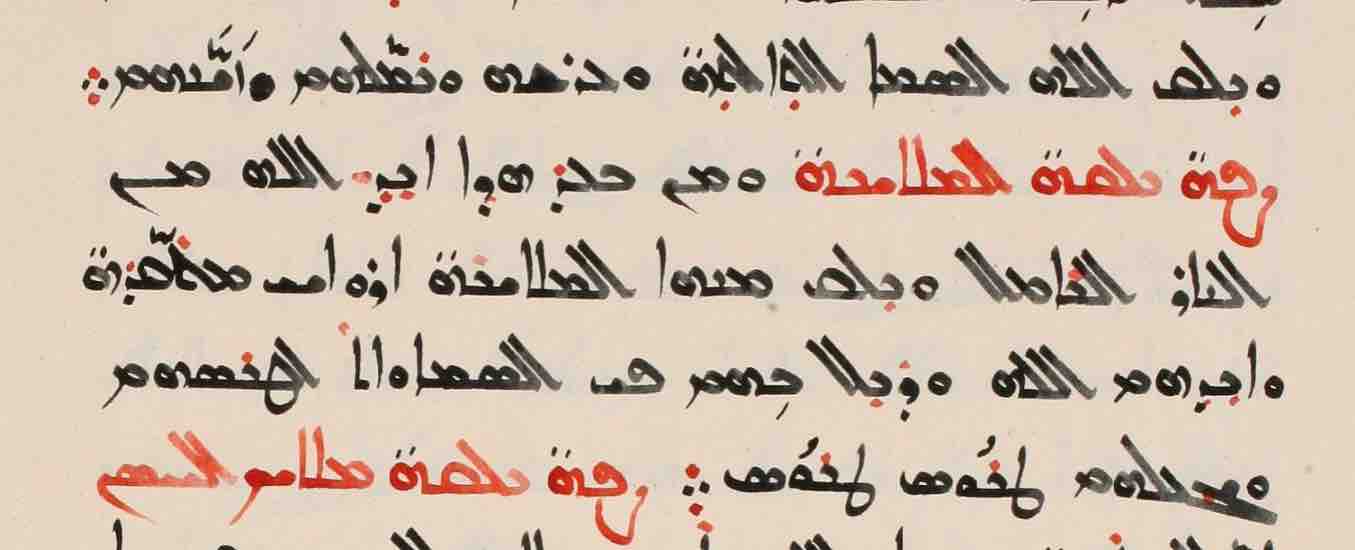Lesson
Syriac Scripts - 20th/21st century, Serto

Description
The living tradition of Syriac writing continued in the age of print, with interesting adaptations to new materials.
Overview
The object of this lesson is threefold:
- to serve as a reminder that Syriac manuscripts have continued to be copied up to the present (see further)
- to show the kinds of supports and writing instruments used in these more recent manuscripts
- to offer samples of the continued use of the scripts we have looked at so far
For number 3, there is really nothing unexpected in terms of letter shapes. Estrangela is generally used, if at all, for decorative purposes or titles (much as Blackletter or Fraktur typefaces may be used in English-language newspaper names, for example), but both Serto and East Syriac have continued in regular use throughout the twentieth and twenty-first centuries. While the kinds of supports (such as a composition book or datebook) and writing instruments (pencil, ballpoint pen) may seemingly be more pedestrian than for earlier manuscripts and thus confer upon these modern manuscripts less gravitas, there is not really a new ductus in letter-forms. These manuscripts often appear less carefully executed than at least some earlier copies (some of them are actually drafts for works intended to be printed). Even in earlier periods, scribes who knew how to write, but not necessarily how to write well, nonetheless produced manuscripts.
In what follows, sample pages are thus offered with no comment on the forms of the letters, but a few remarks highlight supports and writing implements.
Example 1 - Through World War II
Diyarbakir, DIYR 270, ff. 17v-18r (dated 1931-35)
Liturgical texts
Diyarbakir, Meryem Ana Syriac Orthodox Church, DIYR 270, ff. 17v-18r. All rights reserved. Image provided by HMML.
Mardin, CFMM 550, p. 3 (dated 1945)
Intended to be a Syriac and Garshuni parallel, but here only the Syriac column is present.
Ibn Sina, translator Bar Hebraeus
Mardin, Church of the Forty Martyrs, CFMM 550, p. 3. All rights reserved. Image provided by HMML.
Mardin, CFMM 232, pp. 12-13 (20th C.)
Note: the text is written in pencil.
The Syriac Church in Malabar
Mardin, Church of the Forty Martyrs, CFMM 232, pp. 12-13. All rights reserved. Image provided by HMML.
Example 2 - Post World War II
Mardin, CFMM 222, p. 152 (dated 1954)
Abraham Gabriel Ṣawmā, The Book of Syriac Instruction
Mardin, Church of the Forty Martyrs, CFMM 222, p. 152. All rights reserved. Image provided by HMML.
Mardin, CFMM 238, ff. 73v-74r / pp. 130-31 (dated 1958)
Yuhanon Dolabani, History of the Qartmin Monastery
Mardin, Church of the Forty Martyrs, CFMM 238, ff. 73v-74r. All rights reserved. Image provided by HMML.
Mardin, CFMM 555, p. 568 (dated 1964)
Notice the footnote at the bottom of the page, in imitation of printed texts, and the catchword, a regular feature of manuscripts.
Ḥunayn ibn Isḥāq
Mardin, Church of the Forty Martyrs, CFMM 555, p. 568. All rights reserved. Image provided by HMML.
Midyat, MGMT 81, p. 2 (dated 1968)
This manuscript is written in a kind of composition book, like the previous example CFMM 555, here divided into fixed columns.
Dionysius bar Salibi, Commentary on Genesis
Midyat, Mor Gabriel Monastery, MGMT 81, p. 2. All rights reserved. Image provided by HMML.
Midyat, MGMT 83, p. 3 (dated 1971)
This manuscript is paginated in western Arabic numerals and in Syriac letters. As with MGMT 81 the text is copied into a composition book with two columns, and as with CFMM 555 there is a footnote.
Anthology on Liturgical Topics
Midyat, Mor Gabriel Monastery, MGMT 83, p. 3. All rights reserved. Image provided by HMML.
Mardin, ZFRN 385, ff. 3v-4r (dated 1992)
This manuscript, a collection of three saints’ lives copied into a 1992 calendar book, is, according to the colophon, based on a much older manuscript on parchment from 1496 AG (= 1184/5 CE).
Mardin, Dayr Al-Zafaran Monastery, ZFRN 385, ff. 3v-4r. All rights reserved. Image provided by HMML.
Example 3 - 21st-century manuscripts
Jerusalem, SMMJ 475, pp. 9-10 (dated 2012)
Like the previous example MGMT 83, this is paginated in western Arabic numerals and in Syriac letters.
Jacob of Serugh, Memra on the End and Gehenna
Jerusalem, Saint Mark's Monastery, SMMJ 475, pp. 9-10. All rights reserved. Image provided by HMML.
Ready to transcribe?
Try your hand at transcribing 20th and 21st Century - Serto scripts